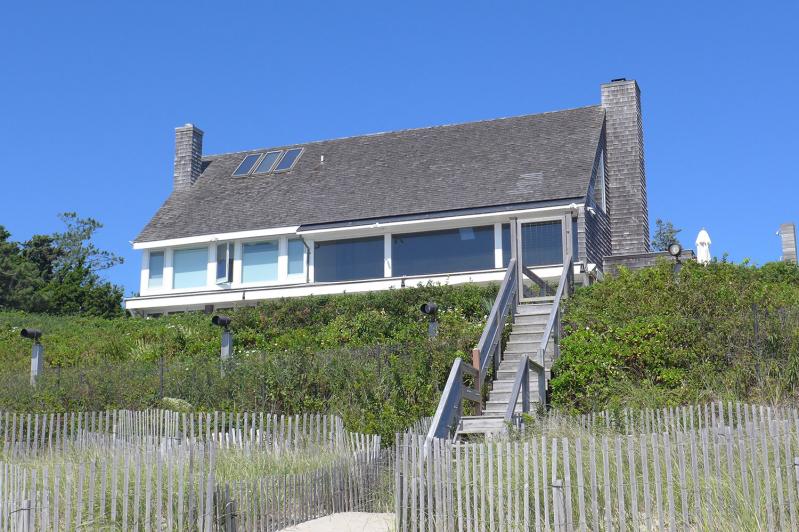At the conclusion of last month’s meeting of the East Hampton Village Zoning Board of Appeals, the owners of 33 Lily Pond Lane told the board they would abandon their plan to tear down the house there and build a new one on the property, which is in a coastal erosion hazard area. On Friday, however, they said they had changed their minds and now want members to vote on the proposal.
Leonard Ackerman, an attorney for Norman and Helene Stark, the owners, has asked the board to issue a determination at its next meeting, on Friday, Oct. 11. If the board were to deny the application, Mr. Ackerman said Tuesday, the Starks will challenge the decision in court.
“This is bigger than Lys Marigold” [the Z.B.A. chairwoman], he said, arguing that a denial meant, in effect, that the board had created a new coastal erosion law, one that would severely devalue oceanfront properties in the hazard area by preventing owners from building a house to their liking. Prospective buyers would not find those properties as desirable, he said, because they would be forced to keep an existing house. The lawyer suggested that other owners of oceanfront property in the village would likely join the Starks’ lawsuit.
The zoning code allows for a building permit in a coastal erosion hazard area if construction is deemed “reasonable and necessary‚” and “not likely to cause a measurable increase in erosion.” The criteria for obtaining variances for the actual construction include demonstrating that no reasonable, prudent alternative site exists, and that the variances requested are the minimum necessary to overcome any practical difficulty or hardship.
Environmental consultants for the Starks have said construction would not have an adverse impact on the erosion zone, and other advisers have said the steeply sloped topography at the north end of the property prevents them from building a new house outside the hazard area, thus causing them practical difficulty and hardship.
Along with the letter from Mr. Ackerman, a legal memo by Linda Margolin, another lawyer for the Starks, was sent to the board on Friday. In the memo, Ms. Margolin cited several determinations by previous boards that permitted building in the hazard area.
In 2006, she pointed out, Mort Zuckerman, the media executive, was grant ed permission to build staff quarters, including a sitting room, a bedroom, and a bath on the first floor, and two new guest bedrooms and baths on the second floor, all within the coastal erosion hazard area. She said the board in that case and others had interpreted the term “practical difficulty” to take into account the strictures of having a home in the hazard area, and had granted variances to allow applicants to build within it.
“The board should — and in fact it is obligated to — respect its own precedents in deciding this application,” Ms. Margolin said.
The Starks’ application was first heard in January. Since then, Z.B.A. members have repeatedly pointed out the difference in impact to the hazard area between renovating an existing house and constructing a new one. The board has historically been willing to allow the former, but not the latter.
Even Mr. Ackerman has acknowledged that his clients’ application is a rarity. At the January hearing, he commented that “in my 45-plus years appearing before the board, there was only one other case in which a complete house was built in a coastal erosion zone.” (The reference was to a house on West End Road owned by Peter Morton, co-founder of the Hard Rock Cafe restaurant chain, that was destroyed by fire in 2015.)
In her memo, Ms. Margolin said the board should not apply a different standard to new construction, because, she said, the erosion zone poses the same practical difficulty to the Starks as it does to homeowners who seek only to renovate.
At last month’s Z.B.A. hearing, Paul Jacobs, whose wife owns 37 Lily Pond Lane, which is next door to the Starks, opposed the application. He said it failed to meet variance standards, arguing that the 1.76 acre property offers alternative spots outside the coastal erosion hazard area to build a new house; and because renovating the existing house, not demolishing it and building anew, would have the most minimal impact on the area.
Mr. Jacobs warned board members that if they approved the Starks’ application and accepted the argument that simply having a house in the coastal erosion zone constituted a hardship, they would set a precedent that every homeowner in the zone would cite as permission to build again from scratch. “The zoning board is the steward of the land and the ocean,” he said. “Your job is to protect it, not to go down a slippery slope that ultimately disturbs the erosion zone.”
When Raymond Harden, the board’s vice chairman, along with Lawrence Hillel and Craig Humphrey, said their concern about setting such a precedent was preventing them from approving the application, Mr. Ackerman initially acquiesced, and said the Starks would agree to renovate the existing house instead.
On Tuesday, Mr. Ackerman said he had been thrown off guard at that hearing because of the board’s unwillingness to find a solution for the Starks, who, since their initial application, have drastically scaled back their plans at the Z.B.A.’s request. “Now I’m tired of playing this horse-trading game,” the lawyer said. “This is bullshit.”

